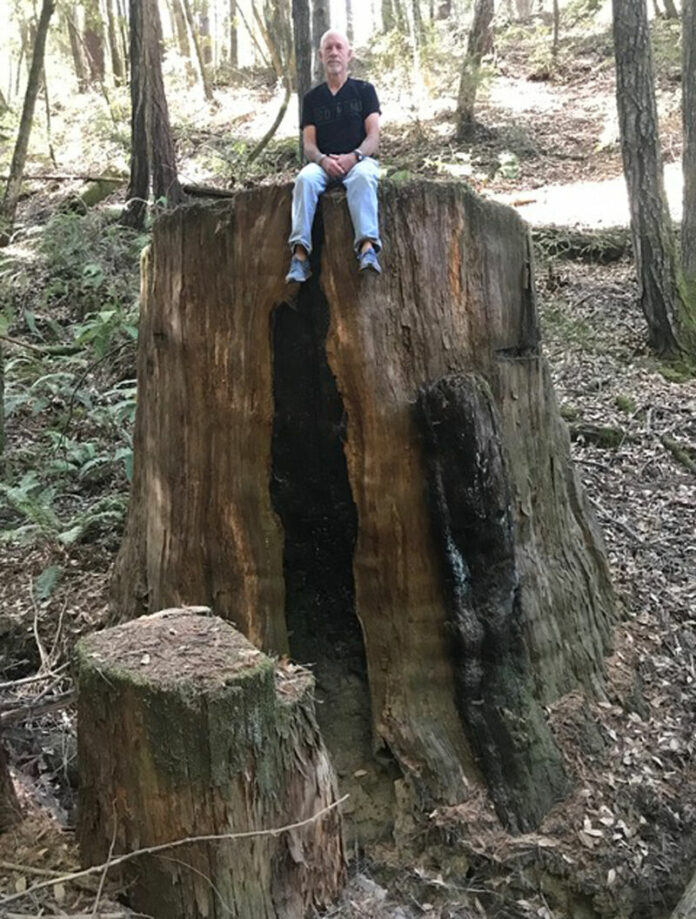Sonoma County Conservation Council’s “Environmentalist of the Year” award to Rick Coates and Chris Poehlmann
The Sonoma County Conservation Council bestowed this year’s Ernestine I. Smith “Environmentalist of the Year” award upon three local luminaries of the environmental justice movement at its holiday networking and environmental awards ceremony Friday, co-hosted with the Sonoma Group of the Sierra Club.
The council named Maya Khosla, Rick Coates and Chris Poehlmann as its three “forest champions.” Khosla is a wildlife biologist, filmmaker and poet laureate of Sonoma County whose recent Legacy Project sought to address the 2017 Tubbs Fire and regeneration with poetry in open spaces, as stated by her website. Meanwhile, the careers of Coates and Poehlmann draw them deep into the West County forests and often the courtroom, maneuvering the legal system to prevent logging projects that jeopardize regional watersheds and forests.
“Not all grassroots organizers are really good at the technical bureaucracy of multi-page permits, understanding the fine details, but these two men have been really, really good at both of those, and try to do as much as possible within the regulatory framework,” according to Wendy Krupnick, council secretary and a member of the annual event’s organizing committee. “But occasionally, when that does not work, the only avenue left is a lawsuit.”
She said the Sonoma County Conservation Council (SCCC) receives nominations from the broader environmental justice community for review by a subcommittee of primarily members of the SCCC’s board of directors. The awardees receive a certification from the California state legislature honoring their contributions to environmental advocacy, Krupnick said.
Rick Coates goes toe to toe with CalFire
Rick Coates was clearing the brush around his house in the Cazadero hills the week of the awards ceremony to reduce fire risk. Most of his leadership skills were forged in the Boy Scouts, he said, rising up in his youth to organize camping trips after the death of his troop’s scoutmaster.
Decades later, Coates co-founded Forest Unlimited and now serves as the executive director of the nonprofit forest and watershed protection organization that educates the public on forestry law and the logging plan review process, funds forest restoration projects and tracks logging plans in Sonoma and Napa counties.
Forest Unlimited trains teams to sling legal challenges to entities like the California Department of Forestry and Fire Protection, better known as CalFire in defense of creeks and old-growth trees.
“We sue them on average about twice a year, I guess. Twenty-six years. I don’t believe we’ve ever lost a case against them,” Coates said. “One of the big ones was when we sued The Bohemian Club.”
He clarified that while Forest Unlimited sometimes launches its own lawsuits, his organization typically aids other groups by fundraising and educating members on forest law and regulations.
According to Coates, CalFire approves logging plans that actually exacerbate fire danger when more fire-prone brush, pin oak, bay and chaparral trees grow in the wake of felled conifer trees. He said the loss of redwood trees reduces shade and humidity, growing the grasslands. “They make a great team with PG&E for starting fires,” Coates said.
Regarding his Ernestine I. Smith award, Coates characterized his commitment to the cause as more of an addiction, saying he’s sown the seeds of numerous nonprofits over the years, like EcoRing, an organization for eco-tourism and green travel.
“I always feel a little uncomfortable about that because no one person actually can do much of anything without a lot of help from a lot of unnamed people that donate their time, their services and their money to help make it happen,” he said.
The Guerneville Forest Coalition in particular fills him with pride. Coates said Forest Unlimited helped form the group engaged in a logging plan battle near Guerneville.
“About 90% of it is within the scenic highway corridor. They’ve found all kinds of problems with erosion. Its parcel contains the Clar Tree, the tallest redwood in Sonoma County and at one time, considered the tallest in the state. There’s a number of endangered species involved. They’ve done an excellent job of getting involved with the review process at the Department of Forestry. It remains to be seen whether CalFire will actually approve it properly or not,” he said.
“But that’s not our only program. We, of course, plant a lot of trees,” Coates said. According to Forest Unlimited’s website, volunteers with the organization have planted thousands of redwood and oak trees over the years at places like the Wildwood Retreat Center in Guerneville, the hills of Cazadero and the Santa Rosa Junior College’s Shone Farm near Forestville.
Coates said Forest Unlimited plans to continue its annual January tree-planting events with observation of COVID-19 safety requirements. “We won’t be able to field as many people this time, but we’re still planning to put about a thousand trees in the ground.”
Chris Poehlmann answers to the Gualala River Watershed
Chris Poehlmann said he lives on an eight-acre homestead on a ridgetop between Little Creek and Grasshopper Creek in Annapolis. He joined Friends of Gualala River in the early 1990s and, according to the SCCC’s brief biography of him, Poehlmann has dedicated 15 years to volunteering with the organization, seven of which as president, building alliances and legal, fundraising and protest efforts.
He remains active on the Education and Outreach Committee of Friends of Gualala, or FoGR, the organization’s website said. The organization’s mission is similar to Forest Unlimited, with a team of advocates waging legal battles against timber harvest plans and other development projects in the name of the Gualala River watershed.
Poehlmann said, “We always liken it to whack-a-mole because you finish with one and all the sudden something else pops up.”
FoGR is locking horns with CalFire in a state appeals court right now, filing one lawsuit in collaboration with the national Center for Biological Diversity over the “Dogwood THP,” or timber harvest plan, to protect endangered species and the watershed’s oldest trees on five miles of floodplain, he said over email. Poehlmann said the current action is over the Dogwood THP of the Gualala Redwood Timber Company.
“Basically, this is all done under the venue of the permitting process,” he said of the organization’s work. “The lead agency is CalFire and they have the very interesting task of not only protecting California from fire and responding to it but also regulating timber harvest at the same time.”
Poehlmann said a movement was underway to “divorce” these two functions of CalFire due to conflicts of interest.
“You have to get up to speed really quick, figure out, okay, these registered professional foresters under the employ of people who want to do these projects are turning in these plans, and then you have to play by the rules of how you can comment, what the deadlines are,” he said.
Poehlmann said his crew has come to understand that, “as Bob Dylan says, money doesn’t talk, it screams” and there comes a time when lodging a suit is the only way the public can defend the environment from a project’s impacts.
“You are behind the power curve as far as the power to change things and effect how these plans are done, just the way that it’s set up. That’s our observation,” he said.
Poehlmann said recovering the forests to sequester atmospheric carbon is one of the people’s main hopes to prevent a climate disaster. “And we feel that in effect, they are being treated as a tree farm right now,” he said.
Poehlmann notes in his approach to timber harvest plans that the present economic system depends on continual growth and product output, but “there’s no system in nature that does that.”
He said, “There’s always limits and we’re trying to kind of crank these forests, always make them have continual growth and more … products for the owners and for their profits. It’s not going to work. I mean, they have to be managed, in my mind, for recovery and the ultimate good for the earth versus some tawdry, profit-making future. So there you have my little soapbox right there.”
Poehlmann said that among its legal actions, FoGR is exploring ideas to establish parks and more opportunities for communities to visit the Gualala River. “If you can’t access something, if you can’t get to know something, you’re not going to love it,” he said. “We’re trying to get access to the public to the rivers so that they see how incredible it is and that we’ll recruit defenders that way.”
This knowledge of place is incredibly important. “You live by watersheds. When I described where I lived, I mentioned two creeks,” he said. “Gary Snyder, who was a great California poet, is a past master of this thinking of watersheds. When someone asks you where you live, the first thing you should say is where your watershed is. And our watershed is the Gualala River watershed.”
Poehlmann said he feels deeply honored to receive the “Environmentalist of the Year Award” and recognition from people he considers his heroes far more experience and time devoted to environmental action in the local region.
73.5
F
Healdsburg
April 21, 2025









